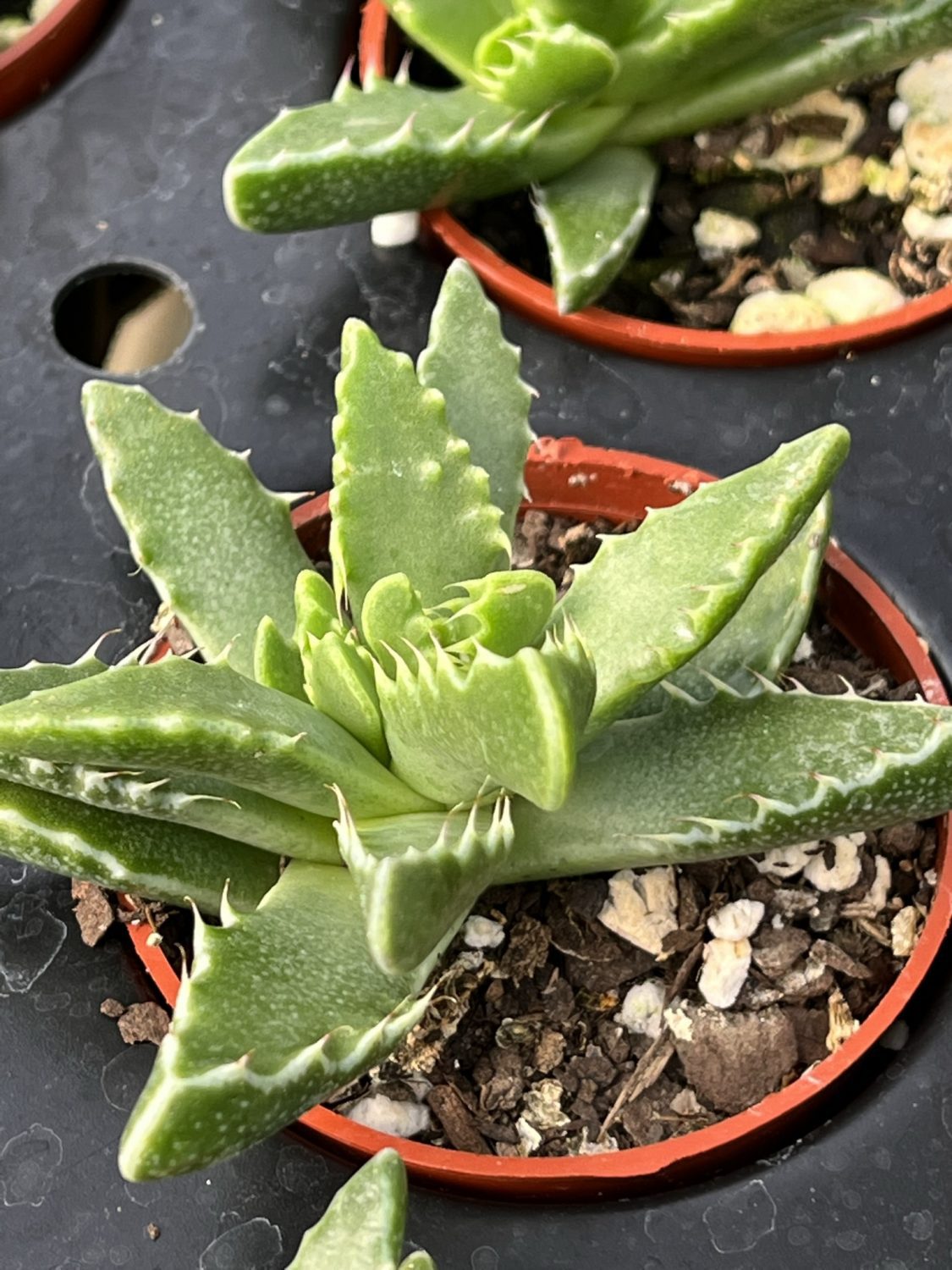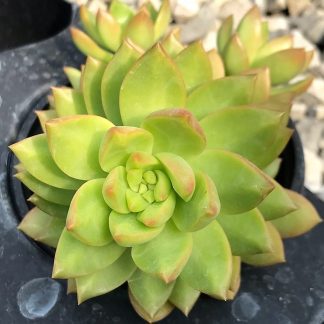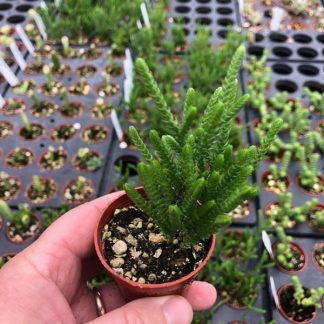Description
Tiger Jaws (Faucaria tigrina): A Friendly Guide to Growing and Loving This Toothsome Succulent
Meet Tiger Jaws
Imagine a plant that looks like it could bite, yet feels soft in your hands. That is Tiger Jaws. We call it that because each leaf ends in small, tooth-like points that remind us of a smiling tiger. The bold look pulls you in. The easy care keeps you hooked. In other words, this succulent gives us dramatic style without daily fuss. Let’s explore how to welcome it into our homes and gardens.
Where Tiger Jaws Comes From
Tiger Jaws grows wild in the arid valleys of South Africa’s Eastern Cape. Hot days, cool nights, rocky soil, and scarce rain shape its life. Instead of deep roots, it clings to rough ground and gathers quick sips of water when storms pass. After more than a century in cultivation, it now travels the globe with us. We can learn from its homeland. Knowing where it started guides every care choice we make.
How to Spot That Smile
Tiger Jaws forms a tight rosette of thick, triangular leaves. Each leaf shows 6–10 soft “teeth” along the edges. They look sharp but feel gentle, almost rubbery. The upper leaf surface holds tiny bumps called epidermal windows. These windows channel light deep into the leaf, helping the plant store energy. Color shifts with sun and season. Bright light brings lime-green tones with golden tips. Cooler weather can blush the edges bronze or pink. When autumn arrives, bold yellow daisy-like blooms appear, opening wide in the afternoon sun and closing at dusk. But most of all, the plant’s grinning form grabs our attention and sparks conversation.
Life in the Wild
In nature, Tiger Jaws faces extremes. Summer heat soars above 90 °F. Winter nights drop toward 40 °F. Rain may vanish for months. Instead of panicking, the plant stores water in fat leaves and pauses growth. Shallow roots spread wide, not deep, catching every drop that drips through rocky crevices. Light is fierce, yet nearby stones cast quick shade each afternoon. Understanding this rhythm helps us mimic good conditions at home.
Home Setup: Pots, Soil, and Placement
We begin with the right container. Choose a pot only 1–2 inches wider than the rosette. A snug pot keeps roots compact and less likely to rot. Drainage holes are not optional—they’re vital. Terra-cotta breathes and pulls extra moisture from soil, which Tiger Jaws loves. Plastic works too if you watch water closely.
The perfect soil drains fast. Blend two parts cactus mix with one part coarse pumice or poultry grit. Instead of peat, use coconut coir or fine bark. These ingredients resist packing down and keep tiny air pockets around roots. Press lightly; do not hammer soil tight.
Place the pot on a bright windowsill facing south or west. Outdoors, raise it on a sturdy shelf or bench so air flows beneath. Good air keeps leaves clean and disease away.
Light: Sun Kisses and Shade Breaks
Tiger Jaws craves strong light for its famous form. Aim for six hours of direct sunlight every day. Morning or late-afternoon rays feel gentle. Midday summer sun can scorch in very hot zones, so give light shade cloth or a neighbor plant that casts dappled shade after noon.
Indoors, rotate the pot a quarter turn each week. Even light helps every leaf grow straight. Pale, stretched leaves mean too little light. Move closer to glass or add a grow lamp. Bright, chunky leaves with bold color tell us we found the sweet spot.
Water: Sip, Don’t Guzzle
Watering may feel tricky, but simple rules help. Instead of calendar dates, rely on soil feel. Push a wooden skewer two inches deep. If it comes out dry and clean, it’s time to water. If crumbs stick, wait another day.
When you do water, soak fully until water pours from the drainage holes. In other words, give a deep drink, then walk away. Empty the saucer so roots never sit in puddles. During active growth—spring and fall—you may water every 10–14 days. Hot midsummer dormancy cuts needs in half. Winter dormancy can mean once a month or less. Leaves wrinkle slightly when thirsty; they grow soft and translucent when over-watered.
Temperature and Humidity
Tiger Jaws feels happiest between 65 °F and 85 °F. It can handle brief dips to 40 °F but not frost. Bring pots indoors before nights drop below 45 °F. Unlike many houseplants, this succulent loves dry air. Typical indoor humidity under 40 % suits it fine. After more than one chilly draft, however, leaf tips may brown. Keep it away from air vents and rattling windows.
Feeding Time: Fertilizer Tips
Because Tiger Jaws evolved in poor soils, heavy feeding harms more than helps. Instead of buffet-style fertilizer, give a light snack. Use a balanced organic cactus fertilizer diluted to half strength. Feed once in early spring and once in early fall. Skip feeding during dormant summer heat and cold winter months.
Too much nitrogen makes leaves swell fast. They may split or grow floppy. Balanced, gentle feeding supports sturdy leaves and bright blooms without bloating.
Seasonal Care Calendar
- Early Spring (March–April)
- Resume watering when days warm.
- First light feed of the year.
- Check for root crowding; repot if roots circle pot walls.
- Late Spring to Early Summer (May–June)
- Growth peaks. Water when soil dries.
- Watch for mealybugs hiding between leaves.
- Provide afternoon shade if sun feels harsh.
- High Summer (July–August)
- Growth slows. Water sparingly.
- Skip fertilizer.
- Check that soil remains loose and breathable.
- Early Fall (September–October)
- Growth restarts. Water more often but still let soil dry.
- Second light feed.
- Enjoy yellow blooms through early November.
- Late Fall to Winter (November–February)
- Move indoors where nights stay above 45 °F.
- Water once the potting mix is bone-dry.
- Offer as much window light as possible.
Propagation: Growing New Smiles
Tiger Jaws rarely sets seeds indoors, but division and leaf cuttings make sharing easy. Look for pups—small offsets clustering around the mother rosette. After watering, slide the entire plant from the pot. Gently tease pups away with a clean, thin knife. Let wounds dry two days, then plant each offset in fresh, dry mix. Wait another week before watering. In four to six weeks, roots grab hold and new teeth emerge.
Leaf cuttings need patience. Twist a firm leaf from the base, making sure no tissue tears away. Lay it flat on barely moist sand. Keep bright shade and dry air. Tiny plantlets sprout at the severed edge in two to three months. Move them to their own pots once they show roots.
Common Problems and Quick Fixes
- Soft, Mushy Leaves
- Cause: Over-watering or poor drainage.
- Fix: Remove soggy leaves, let soil dry, and repot in faster-draining mix.
- Shriveled, Wrinkled Leaves
- Cause: Under-watering or very low humidity plus heat.
- Fix: Give a deep drink and place away from hot drafts.
- Leaf Tips Browning
- Cause: Cold draft or salt buildup.
- Fix: Move to warmer spot; flush soil with distilled water.
- Mealybugs
- Cause: Warm, still air.
- Fix: Dab pests with cotton swab dipped in 70 % isopropyl alcohol. Rinse after ten minutes.
- Etiolation (Stretched Leaves)
- Cause: Low light.
- Fix: Increase sun exposure gradually or install a grow lamp.
Creative Styling and Display
Tiger Jaws adds playful drama wherever we set it. Instead of hiding it behind taller plants, raise it to eye level on a sunny shelf. Try pairing with round, smooth succulents like Echeveria or purple Graptoveria to contrast the toothed edges. Shallow bonsai dishes filled with coarse sand let multiple pups form a living tiger-Jaws colony. You can inset bright stones—orange calcite, black lava, creamy quartz—between rosettes. The stones echo its natural rocky habitat and reduce soil splash.
For outdoor decks, place three matching terra-cotta pots side by side. Plant Tiger Jaws in the center and drape trailing Portulaca on each side. The blooms mingle, creating a summer smile line. If you live in cooler zones, remember to gather the pots before frost. After more than one season, you may find these displays become a signature feature of your space.
Community Connections and Stories
We do not garden alone. Sharing Tiger Jaws stories builds community. Host a “Succulent Swap Sunday.” Invite friends to trade offsets, soil tips, and joyful struggles. We learn faster by watching each other repot and prune. Many children love counting the “teeth” and drawing cartoon tigers beside the pot. Teaching them safe plant handling grows future stewards.
Online groups also help. Post progress photos every six months. Show how color deepens with light or how pups multiply. Instead of scrolling past quick likes, explain what worked and what failed. Together, we turn simple plant care into a living, growing conversation.
Fun Facts That Spark Smiles
- The Latin name Faucaria comes from “fauces,” meaning jaw or throat.
- Older plants can show over 20 teeth per leaf, yet the points stay harmless.
- Flowers smell faintly of honey on warm afternoons. Place your nose close and see.
- A mature rosette may reach only four inches wide, making it perfect for compact shelves.
- Tiger Jaws joins the ice plant family, Aizoaceae, famous for water-filled leaves.
- In habitat, colonies absorb morning dew through leaf windows, sipping instead of slurping.
Embracing the Toothsome Journey
You now hold the keys to a grinning, golden-flowered wonder. We met its desert roots, felt the rhythm of its seasons, and practiced gentle care steps that keep every toothy leaf firm and bright. Bring Tiger Jaws into your home, share offsets with friends, and let its cheerful bite spark daily joy. Happy growing, and may your windowsills smile back at you every day!




